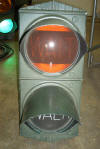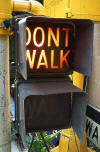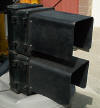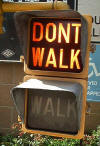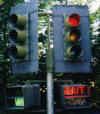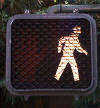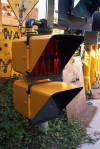|
|
Pedestrian Signals |
|
Be sure to click on the photos for closer views!
Listings proceeded by a "*" symbol have animated photos...just click to view the signal in action!
![]()
Crouse-Hinds
CROUSE-HINDS PEDESTRIAN SIGNAL- Nice example of an older pedestrian signal with 8" WAIT / WALK indications. Signal uses round door latches and integral visors (not fastened on). I also have an Eagle version of this signal, but it has wing nut fastened doors and bayonet mounted visors.
NEWER CROUSE-HINDS PEDESTRIAN SIGNAL- Newer style aluminum signal from the 70's with square 9" lenses. Signal featured both polycarbonate and glass lenses.
![]()
Eagle
EAGLE PEDESTRIAN SIGNAL- Here is the 9" version of the eagle pedestrian signal with long tunnel visors. This version also has a curved top and bottom. Later versions were flat. Oler eagle pedestrian signals employed the use of "double doors". The first door gains access to the lamp, reflector, and lens, while the second door gains access to the wiring and pip mount.
Another Eagle signal with cutaway visors. This newer signal has plastic lenses instead of glass. Signal is quite similar to the Crouse-Hinds version.
![]()
Econolite
 ECONOLITE NEON
PEDESTRIAN SIGNAL- These
signals were once common
throughout Southern
California. They consisted of
bent neon tubing with the
words "WAIT" IN ORANGE, and
"WALK" in green.
ECONOLITE NEON
PEDESTRIAN SIGNAL- These
signals were once common
throughout Southern
California. They consisted of
bent neon tubing with the
words "WAIT" IN ORANGE, and
"WALK" in green.
 WALK
/ DON'T WALK NEON SIGNAL- This
is an example of the "Don't
Walk" version of the neon
signal head. Note that it is
one of the only types that
ever employed the appropriate
apostrophe between the "N" and
the "T". The "Walk" display is
also green on this signal.
Both of these signals are very
heavy due to the two
transformers that are located
inside. This one is also made by Econolite.
WALK
/ DON'T WALK NEON SIGNAL- This
is an example of the "Don't
Walk" version of the neon
signal head. Note that it is
one of the only types that
ever employed the appropriate
apostrophe between the "N" and
the "T". The "Walk" display is
also green on this signal.
Both of these signals are very
heavy due to the two
transformers that are located
inside. This one is also made by Econolite.
* This picture is a typical example of the two way Econolite signal display most popular in the 50's and 60's in California. The signal here shows the older neon "WALK/WAIT" signals that were in use prior to the popular "DON'T WALK" indication that was used later. Most signals made use of the 8" back plate except for Los Angeles County, which used the smaller 5" type.
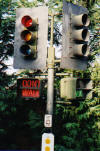 * A
view of another set of two-way
Econolite Signals showing the
newer neon "WALK/DON'T WALK"
signals. Both neon signals use
heavy-duty transformers. The
signals are all aluminum and
quite heavy...it was quite a
chore to erect both of these
signals in my back yard! This signal, along with it's sister pictured just
above, are two of my all time favorites because they instantly bring back my
memories of Southern California as a kid!
* A
view of another set of two-way
Econolite Signals showing the
newer neon "WALK/DON'T WALK"
signals. Both neon signals use
heavy-duty transformers. The
signals are all aluminum and
quite heavy...it was quite a
chore to erect both of these
signals in my back yard! This signal, along with it's sister pictured just
above, are two of my all time favorites because they instantly bring back my
memories of Southern California as a kid!
And this is Econolite's incandescent signal. It is very similar to other makes, but has a more squared off look to it.
![]()
Indicator Controls Corp.
* INCANDESCENT PEDESTRIAN SIGNAL- Many pedestrian signals utilize common 8" signal lamps that are 67-69 watts. The obvious advantage is when re lamping, only one lamp type is needed. The signal also employs a unique "egg crate" visor that helps shield the sun and also is readable only by the pedestrians directly facing this signal.
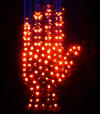
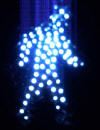
New LED symbol signals really "pop" at night! This module is installed in a standard 16" ICC pedestrian signal case with egg crate visor. The symbols overlap each other and are centered in the head, so that larger symbols can be used.
And here is one of my newest pedestrian signals. It's a genuine LED countdown pedestrian signal. This signal is being used more frequently to help pedestrians see how much time is left to cross the street. This unit "senses" automatically how long the pedestrian "WALK" and "DON'T WALK" time is, and calculates it to display for the next cycle. There are no extra wires or equipment necessary to run one of these, and it's really fun to watch!
![]()
Mc Cain
Incandescent head that utilizes the clamshell mounting on the side.
![]()
Winko Matic
This pedestrian signal featured special colored incandescent lamps to make it operational. the orange DONT WALK lamps were rated at 65 watts each and they were wired in series, so if one lamp would burn out, they both would be extinguished. This was to keep from having a false WALK indication.
![]()
3M
And here is 3M's version of a pedestrian signal. The signal is basically the same as the vehicular head except it uses 75 watt lamps verses the 150 watt lamps. It is fascinating to watch this signal blink "DONT WALK" as the lamps tend to have a "fade out & in" to them when they blink. This particular signal I received form a fellow Signalfan Club member. It is in excellent condition.
![]()
Misc.
Another unusual pedestrian signal that uses colored lamps instead of colored lenses to produce the desired indications. This signal also has a louvered case to disperse the heat from the three lamps inside.
![]()
Vehicular Signals

Home
/
Bio
/
Signals
/
Misc.
/
Signs
/
Controllers
/
History
/
Links
/
Faq's
/
Club/
HO Layout
All contents ©1997-2016
by Signalfan. All rights reserved.

